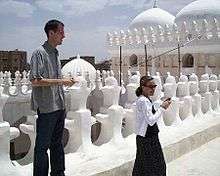Qadad

.jpg)

Qadad (qadâd, kʉðað) or qudad is a waterproof plaster surface, made of a lime plaster treated with slaked lime and oils and fats. The technique is well over a millennium old[1] and can be used as a roof covering.[2]
Volcanic ash, pumice or other crushed volcanic aggregate are often used as pozzolanic agents.
Due to the slowness of some of the chemical reactions, qadad mortar can take over a hundred days to prepare, from quarrying of raw materials to the beginning of application to the building. It can also take over a year to set fully.[3]
In 2004, a documentary film Qudad, Re-inventing a Tradition[4] was made by the filmmaker Caterina Borelli.[5][6] It documents the restoration of the Amiriya Complex, which was awarded the Aga Khan Award for Architecture in 2007.[7]
See also
References
- ↑ see Great Mosque of Sana'a
- ↑ Sutter, Anita (18 December 2006). "Note sur la fabrication du qadâd". Arabian Humanities. Retrieved 13 February 2016.
- ↑ "Fodde. The Architecture of Mud and Qudad. DVD Reviews". Internet Archaeology. intarch.ac.uk.
- ↑ Resources, Documentary Educational. "DER Documentary: Qudad". www.der.org.
- ↑ docued (11 September 2008). "Qudad, Re-inventing a Tradition - PREVIEW" – via YouTube.
- ↑ "Qudad, Re-inventing a Tradition". Documentary Educational Resources.
- ↑ "Restoration of the Amiriya Complex - Aga Khan Development Network". www.akdn.org.
-Jerusalem-Temple_Mount-Dome_of_the_Rock_(SE_exposure).jpg)